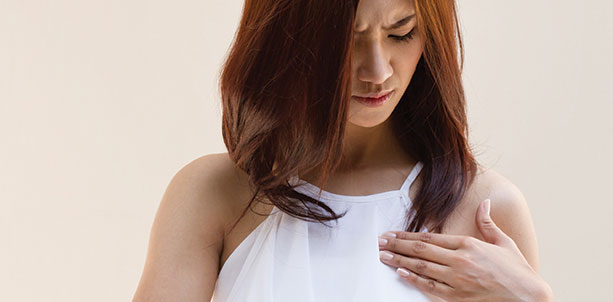October has become synonymous with Breast Cancer Awareness and the pink ribbon. This little symbol is placed on products of many kinds and incorporated into “cute” marketing programs. In our offices we celebrate Breast Health Month. We are all too aware of breast cancer. What we need is more money and education toward prevention. Many of the items showcasing the pink ribbon contain known carcinogens, especially in foods and personal care products. This hypocrisy doesn’t make up for small percentages of donated funds. Also, women who have undergone treatment for breast cancer, do not find it “cute”. Yes, it is wonderful to acknowledge what they have been through, their strength and determination. Men wearing pink tights doesn’t make a difference to women’s health. I would like to see the focus change from recognizing them to helping their daughters have a brighter health future. Breast thermography is a part of a comprehensive and personalized breast health program.
Breast and Full Body Thermography has become a better-known screening tool1 among the health community in the last few years. The technology has been featured in many health webinars, natural medicine newsletters, and studies.
Many people, who are aware of thermography, equate it with cancer detection and “hot spots”. This is not the truth or the value of the screening. Here’s the truth about thermography. Digital Infrared Thermal Imaging (or DITI) uses a special very sensitive infrared camera to capture images related to the heat coming off the body. It is completely safe, as it is not putting anything into the person.
There is no radiation, compression, touching or pain.
The temperature differentials in the images can be interpreted by well-trained professionals and valuable health screening information can be ascertained.
Some findings are specific and can be followed up immediately with other tests. Looking at change over time is the best way to look at thermal imaging, and it is good to get a baseline before there is an issue. A baseline is established by having initial scans and then repeating the breast scans in a three-month time frame. This has been found to be the effective way to develop the thermal fingerprint in the breasts, and the process is elaborated on later in this article.
The images are not diagnostic, but rather a health assessment tool to help the person follow up on abnormal patterns. Because thermography is a test of physiology not anatomy, some things may be seen in the early developing stages before it becomes evident to the person as a problem.
What is the difference between anatomy and physiology?
Anatomy is structure, like your lungs. Physiology is a function, like your lungs expanding and contracting when you breathe.
Chronic diseases do not come on overnight. That would be an acute condition like an infection or injury. Chronic diseases like degenerative arthritis may start years before the symptoms are felt or diagnosed. It is helpful to know something may be developing, instead of waiting for it to happen. The individual can make corrective lifestyle changes and have additional testing specific to the findings. This is truly pro-active, preventative medicine.
One of our long-time patients had a shift in her normal “thermal fingerprint” on an annual breast scan. She followed up with changes in her diet and exercise. We were able to see improvement in her normal patterns, but there were still concerns. She had additional screening with a test of anatomy and there was no current diagnosis. Her health status was of particular concern because her twin sister had been diagnosed with breast cancer years before. We monitored her breast health as she balanced her hormones and continued with a healthy lifestyle. She returned to her baseline temperatures and has been doing well for several years since. While we can’t know for sure what would have happened if she didn’t get the information that her breast health was not stable, things might have had a different outcome. It was very satisfying to help this lovely lady stay well.
This is one of the many times we were able to use breast thermography as a wellness tool. Our goals are not just detection, but prevention.
Some women choose to do integrative or all-natural treatments for low-grade breast cancer. Although we do not offer an opinion, we are here to help them make the best-informed decisions. We can monitor their treatment with thermography as an objective tool. We have seen some treatments stabilize with the thermal findings, and this has been corroborated with breast MRI and other conventional testing means. We have also seen patients who believe their holistic treatments are effective, but the thermal images show a different story. This enables the patient to make different choices, even within the natural medicine arena.
When should you begin have breast thermography?
Breast thermography is safe at any age, but in young women it’s best to wait until there is more hormonal stability. We would like to start scanning young women with significant concerns by 30. Because young women are being diagnosed with breast cancer in increasing numbers, other screenings may not be appropriate, beginning thermography before 40 is recommended.
In the first year, we develop what is called a thermographic breast baseline or “thermal fingerprint”. This is accomplished by having one set of breast scans done and repeating the breast scans three months later. After the first year, if everything remains stable with the established baseline, we screen every year. Because thermography is looking at change over time, we do want to scan annually. Some activity can become invisible to thermography during a long absence from screening and so it is recommended we keep up annually. It’s not like a mammogram that is looking at the anatomy on that day. This is why we encourage you to keep up with annual scans, to follow the physiology and possible changes.
Is Breast Thermography a Better Test?
Comparing thermography, a physiological screening to a test of anatomy is like comparing apples to oranges. Each screening has its own strengths and weaknesses. No test is 100%, so an individualized breast health program makes sense.
Breast lumps—thermography can monitor a breast lump for activity. However, every lump needs to be checked out anatomically at least once. That could be done by ultrasound, a clinical exam by a Doctor, MRI or mammogram. Once it has been established to be a cyst or other benign tissue, thermography can be utilized to monitor changes. Even if a breast lump shows up as normal on thermal imaging, if there hasn’t been a test of anatomy, it must be done.
Non-specific finds on tests of anatomy can be followed for activity or changes with thermography. If something that is considered benign on anatomical testing shows temperature pattern changes, the findings may have changed. Time to monitor it and make some changes. Additional testing may be recommended. Of course, every decision should be made with the participation of a trusted and knowledgeable healthcare practitioner.
As we have discussed previously, as a health assessment tool, thermography is excellent and safe.
Full body thermography has become very popular in recent years as well. Looking at skin temperature with our sensitive infrared camera and sophisticated interpretation software, many areas of the body can be scanned.
What do we typically look for on body thermography?
Images are taken of different areas of the body for skin temperature patterns. The camera is looking at the surface not deep within the body. Interpretation is based on “Thermatomes” and is not like a CT scan or MRI, where you see a picture of the tissue.
In the head and neck, we are looking for areas of increased temperature in the sinus and dental areas, which can be related to infection. Inflammation related to the muscles of the head, jaw, and neck can be helpful in determining the right treatment for various pain issues.
Many biological dentists are referring for thermal imaging to find problem areas in old root canals, under crowns and fillings. General gum issues can be identified and followed up on as well. Lymphatic activity may be seen and can be associated with the dental or sinus issues.
A change in neutral temperature patterns in the thyroid and “thermatomes” related to different organs can prompt someone to do more testing, especially with related symptoms. At the least, they can monitor these changes over time.
Pain can be correlated with areas of inflammation, which is heat.
Even Hippocrates, The Father of Medicine, put mud on his patient to see where it dried first. This is the inflamed area. Technology has improved on his theory. These patterns can help pinpoint the body parts to be addressed with treatment modalities. Very helpful, especially because x-rays can’t show pain. Inflammation in the visible blood vessels can also be an early warning sign, and further testing along with lifestyle modifications can make a big difference.
All the way to the bottom of the feet, where more heat on one foot can show a disturbance in the gait or postural balance. Animals are even benefiting from the growing applications of thermal imaging in veterinary sciences. Since they can’t explain what hurts, like when they a limping, the camera can speak for them. Equestrians are using thermal imaging of horses backs to fit saddles properly, with less pain for the animal.
How to choose a Thermographer?
Thermography has yet to become a well-regulated field, which some consumers are not aware of. You want to make sure you are using a qualified practitioner. Is their camera specific for medical imaging, and not a lesser industrial camera. Is the technician certified by a reputable thermography organization? Do they have the expertise and licensure to review the information with you? Are the interpretations done by a qualified medical professional with certification and peer review? How are the images saved so that you will always have access and not be dependent on one technician? These are just a few of the things to keep in mind.
New innovations including lie detection and advanced medical screenings are being investigated worldwide. It is an exciting time for infrared and all its applications. Affordable and non-toxic health solutions are the way of the future with thermography.
References
- What is Breast Thermography American College of Clinical Thermography
- Manasi B Rakhunde,corresponding author Shashank Gotarkar, and Sonali G Choudhari Thermography as a Breast Cancer Screening Technique: A Review Article Cureus. 2022 Nov; 14(11): e31251. Published online 2022 Nov 8. doi: 10.7759/cureus.31251











